Configuring IPsec Between Two Routers and a Cisco VPN Client 4.x
Available Languages
Contents
Introduction
This document demonstrates how to configure IPsec between two Cisco routers and the Cisco VPN Client 4.x. Cisco IOS® Software Releases 12.2(8)T and later support connections from Cisco VPN Client 3.x and later.
Refer to Configuring an IPsec Router Dynamic LAN-to-LAN Peer and VPN Clients in order to learn more about the scenario where one end of the L2L tunnel is assigned an IP address dynamically by the other end.
Prerequisites
Requirements
Ensure that you meet these requirements before you attempt this configuration:
-
A pool of addresses to be assigned for IPsec
-
A group called 3000clients with a preshared key of cisco123 for the VPN Clients
-
Group and user authentication is done locally on the router for the VPN Clients.
-
The no-xauth parameter is used on the ISAKMP key command for the LAN-to-LAN tunnel.
Components Used
The information in this document is based on these software and hardware versions .
-
Routers that run Cisco IOS Software Release 12.2(8)T.
Note: This document was recently tested with Cisco IOS Software Release 12.3(1). No changes are required.
-
Cisco VPN Client for Windows Version 4.x (any VPN Client 3.x and later works).
The information in this document was created from the devices in a specific lab environment. All of the devices used in this document started with a cleared (default) configuration. If your network is live, make sure that you understand the potential impact of any command.
Output from the show version command on the router is shown in this output.
vpn2611#show version Cisco Internetwork Operating System Software IOS (tm) C2600 Software (C2600-JK9O3S-M), Version 12.2(8)T, RELEASE SOFTWARE (fc2) TAC Support: http://www.cisco.com/tac Copyright (c) 1986-2002 by cisco Systems, Inc. Compiled Thu 14-Feb-02 16:50 by ccai Image text-base: 0x80008070, data-base: 0x81816184 ROM: System Bootstrap, Version 11.3(2)XA4, RELEASE SOFTWARE (fc1) vpn2611 uptime is 1 hour, 15 minutes System returned to ROM by reload System image file is "flash:c2600-jk9o3s-mz.122-8.T" cisco 2611 (MPC860) processor (revision 0x203) with 61440K/4096K bytes of memory. Processor board ID JAD04370EEG (2285146560) M860 processor: part number 0, mask 49 Bridging software. X.25 software, Version 3.0.0. SuperLAT software (copyright 1990 by Meridian Technology Corp). TN3270 Emulation software. 2 Ethernet/IEEE 802.3 interface(s) 1 Serial network interface(s) 32K bytes of non-volatile configuration memory. 16384K bytes of processor board System flash (Read/Write) Configuration register is 0x2102
Conventions
Refer to the Cisco Technical Tips Conventions for more information on document conventions.
Configure
In this section, you are presented with the information used to configure the features described in this document.
Network Diagram
This document uses this network setup .
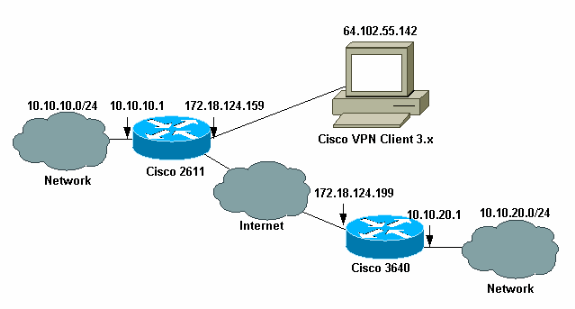
Note: The IP addresses in this example are not routable in the global Internet because they are private IP addresses in a lab network.
Configurations
Configure the Cisco 2611 Router
| Cisco 2611 Router |
|---|
vpn2611#show run Building configuration... Current configuration : 2265 bytes ! version 12.2 service timestamps debug uptime service timestamps log uptime no service password-encryption ! hostname vpn2611 ! !--- Enable AAA for user authentication !--- and group authorization. aaa new-model ! ! !--- In order to enable X-Auth for user authentication, !--- enable the aaa authentication commands. aaa authentication login userauthen local !--- In order to enable group authorization, enable !--- the aaa authorization commands. aaa authorization network groupauthor local aaa session-id common ! !--- For local authentication of the IPSec user, !--- create the user with a password. username cisco password 0 cisco ip subnet-zero ! ! ! ip audit notify log ip audit po max-events 100 ! !--- Create an Internet Security Association and !--- Key Management Protocol (ISAKMP) !--- policy for Phase 1 negotiations for the VPN 3.x Clients. crypto isakmp policy 3 encr 3des authentication pre-share group 2 ! !--- Create an ISAKMP policy for Phase 1 !--- negotiations for the LAN-to-LAN tunnels. crypto isakmp policy 10 hash md5 authentication pre-share !--- Specify the PreShared key for the LAN-to-LAN tunnel. !--- Make sure that you use the !--- no-xauth parameter with your ISAKMP key. crypto isakmp key cisco123 address 172.18.124.199 no-xauth ! !--- Create a group that is used to !--- specify the WINS, DNS servers' address !--- to the client, along with the pre-shared !--- key for authentication. crypto isakmp client configuration group 3000client key cisco123 dns 10.10.10.10 wins 10.10.10.20 domain cisco.com pool ippool ! ! !--- Create the Phase 2 Policy for actual data encryption. crypto ipsec transform-set myset esp-3des esp-md5-hmac ! !--- Create a dynamic map and apply !--- the transform set that was created earlier. crypto dynamic-map dynmap 10 set transform-set myset ! ! !--- Create the actual crypto map, and !--- apply the AAA lists that were created !--- earlier. Also create a new instance for your !--- LAN-to-LAN tunnel. Specify the peer IP address, !--- transform set, and an Access Control List (ACL) for this !--- instance. crypto map clientmap client authentication list userauthen crypto map clientmap isakmp authorization list groupauthor crypto map clientmap client configuration address respond crypto map clientmap 1 ipsec-isakmp set peer 172.18.124.199 set transform-set myset match address 100 crypto map clientmap 10 ipsec-isakmp dynamic dynmap ! ! fax interface-type fax-mail mta receive maximum-recipients 0 ! ! !--- Apply the crypto map on the outside interface. interface Ethernet0/0 ip address 172.18.124.159 255.255.255.0 half-duplex crypto map clientmap ! interface Serial0/0 no ip address shutdown ! interface Ethernet0/1 ip address 10.10.10.1 255.255.255.0 no keepalive half-duplex ! ! !--- Create a pool of addresses to be !--- assigned to the VPN Clients. ip local pool ippool 14.1.1.100 14.1.1.200 ip classless ip route 0.0.0.0 0.0.0.0 172.18.124.1 ip http server ip pim bidir-enable ! ! !--- Create an ACL for the traffic !--- to be encrypted. In this example, !--- the traffic from 10.10.10.0/24 to 10.10.20.0/24 !--- is encrypted. access-list 100 permit ip 10.10.10.0 0.0.0.255 10.10.20.0 0.0.0.255 ! ! snmp-server community foobar RO call rsvp-sync ! ! mgcp profile default ! dial-peer cor custom ! ! line con 0 exec-timeout 0 0 line aux 0 line vty 0 4 ! ! end |
Configure the 3640 Router
| Cisco 3640 Router |
|---|
vpn3640#show run Building configuration... Current configuration : 1287 bytes ! ! Last configuration change at 13:47:37 UTC Wed Mar 6 2002 ! version 12.2 service timestamps debug uptime service timestamps log uptime no service password-encryption ! hostname vpn3640 ! ! ip subnet-zero ip cef ! !--- Create an ISAKMP policy for Phase 1 !--- negotiations for the LAN-to-LAN tunnels. crypto isakmp policy 10 hash md5 authentication pre-share !--- Specify the PreShared key for the LAN-to-LAN !--- tunnel. You do not have to add the !--- X-Auth parameter, as this !--- router does not do Cisco Unity Client IPsec !--- authentication. crypto isakmp key cisco123 address 172.18.124.159 ! ! !--- Create the Phase 2 Policy for actual data encryption. crypto ipsec transform-set myset esp-3des esp-md5-hmac ! !--- Create the actual crypto map. Specify !--- the peer IP address, transform !--- set, and an ACL for this instance. crypto map mymap 10 ipsec-isakmp set peer 172.18.124.159 set transform-set myset match address 100 ! call RSVP-sync ! ! ! !--- Apply the crypto map on the outside interface. interface Ethernet0/0 ip address 172.18.124.199 255.255.255.0 half-duplex crypto map mymap ! interface Ethernet0/1 ip address 10.10.20.1 255.255.255.0 half-duplex ! ip classless ip route 0.0.0.0 0.0.0.0 172.18.124.1 ip http server ip pim bidir-enable ! !--- Create an ACL for the traffic to !--- be encrypted. In this example, !--- the traffic from 10.10.20.0/24 to 10.10.10.0/24 !--- is encrypted. access-list 100 permit ip 10.10.20.0 0.0.0.255 10.10.10.0 0.0.0.255 snmp-server community foobar RO ! dial-peer cor custom ! ! line con 0 exec-timeout 0 0 line aux 0 line vty 0 4 login ! end |
Configure the VPN Client 4.x
Follow these steps in order to configure Cisco VPN Client 4.x.
-
Launch the VPN Client, and then click New in order to create a new connection.
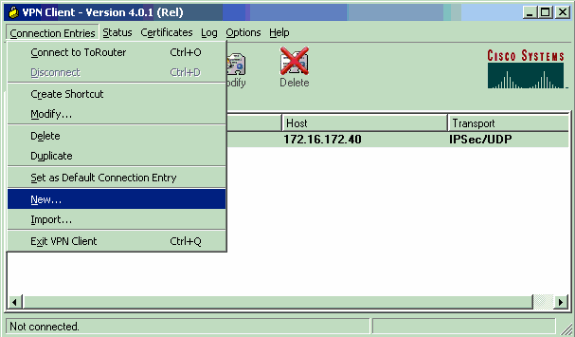
-
Input the necessary information, and click Save when finished.
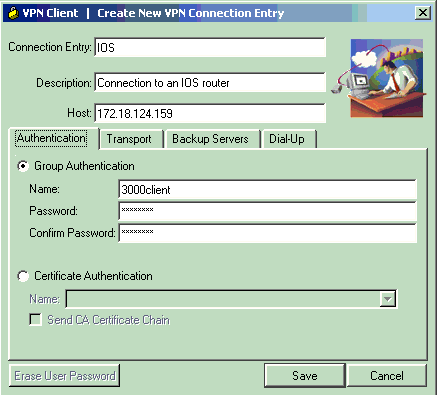
-
Right-click on the newly created Connection Entry, and click Connect in order to connect to the router.
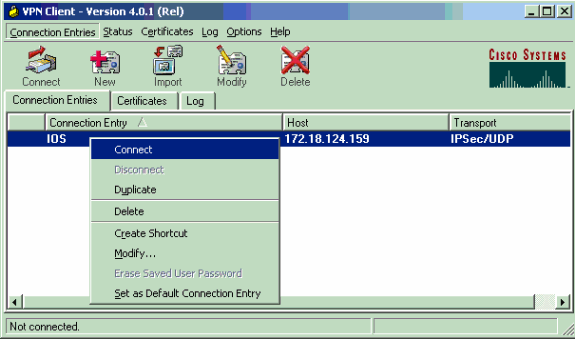
-
During the IPsec negotiations, you are prompted for a username and password.
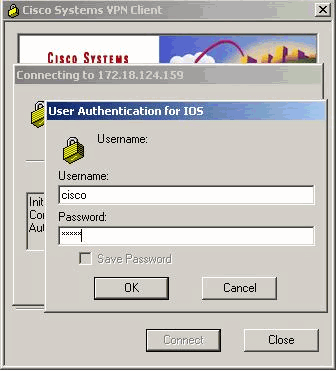
-
The window displays messages that read "Negotiating security profiles" and "Your link is now secure."
Verify
This section provides information that helps you to confirm that your configuration works properly.
Certain show commands are supported by the Output Interpreter Tool (registered customers only) , which allows you to view an analysis of show command output.
Cisco VPN 2611
vpn2611#show crypto isakmp sa
dst src state conn-id slot
172.18.124.159 172.18.124.199 QM_IDLE 5 0
!--- For the LAN-to-LAN tunnel peer.
172.18.124.159 64.102.55.142 QM_IDLE 6 0
!--- For the Cisco Unity Client tunnel peer.
vpn2611#show crypto ipsec sa
interface: Ethernet0/0
Crypto map tag: clientmap, local addr. 172.18.124.159
protected vrf:
local ident (addr/mask/prot/port): (10.10.10.0/255.255.255.0/0/0)
remote ident (addr/mask/prot/port): (10.10.20.0/255.255.255.0/0/0)
current_peer: 172.18.124.199:500
!--- For the LAN-to-LAN tunnel peer.
PERMIT, flags={origin_is_acl,}
#pkts encaps: 4, #pkts encrypt: 4, #pkts digest 4
#pkts decaps: 4, #pkts decrypt: 4, #pkts verify 4
#pkts compressed: 0, #pkts decompressed: 0
#pkts not compressed: 0, #pkts compr. failed: 0, #pkts decompress
failed: 0
#send errors 0, #recv errors 0
local crypto endpt.: 172.18.124.159, remote crypto endpt.:
172.18.124.199
path mtu 1500, media mtu 1500
current outbound spi: 892741BC
inbound esp sas:
spi: 0x7B7B2015(2071666709)
transform: esp-3des esp-md5-hmac ,
in use settings ={Tunnel, }
slot: 0, conn id: 2000, flow_id: 1, crypto map: clientmap
sa timing: remaining key lifetime (k/sec): (4607999/1182)
IV size: 8 bytes
replay detection support: Y
inbound ah sas:
inbound pcp sas:
outbound ESP sas:
spi: 0x892741BC(2301051324)
transform: esp-3des esp-md5-hmac ,
in use settings ={Tunnel, }
slot: 0, conn id: 2001, flow_id: 2, crypto map: clientmap
sa timing: remaining key lifetime (k/sec): (4607999/1182)
IV size: 8 bytes
replay detection support: Y
outbound ah sas:
outbound PCP sas:
protected vrf:
local ident (addr/mask/prot/port): (172.18.124.159/255.255.255.255/0/0)
remote ident (addr/mask/prot/port): (14.1.1.106/255.255.255.255/0/0)
current_peer: 64.102.55.142:500
!--- For the Cisco Unity Client tunnel peer.
PERMIT, flags={}
#pkts encaps: 0, #pkts encrypt: 0, #pkts digest 0
#pkts decaps: 0, #pkts decrypt: 0, #pkts verify 0
#pkts compressed: 0, #pkts decompressed: 0
#pkts not compressed: 0, #pkts compr. Failed: 0, #pkts decompress
failed: 0
#send errors 0, #recv errors 0
local crypto endpt.: 172.18.124.159, remote crypto endpt.:
64.102.55.142
path mtu 1500, media mtu 1500
current outbound spi: 81F39EFA
inbound ESP sas:
spi: 0xC4483102(3293065474)
transform: esp-3des esp-md5-hmac ,
in use settings ={Tunnel, }
slot: 0, conn id: 2002, flow_id: 3, crypto map: clientmap
sa timing: remaining key lifetime (k/sec): (4608000/3484)
IV size: 8 bytes
replay detection support: Y
inbound ah sas:
inbound PCP sas:
outbound ESP sas:
spi: 0x81F39EFA(2180226810)
transform: esp-3des esp-md5-hmac ,
in use settings ={Tunnel, }
slot: 0, conn id: 2003, flow_id: 4, crypto map: clientmap
sa timing: remaining key lifetime (k/sec): (4608000/3484)
IV size: 8 bytes
replay detection support: Y
outbound ah sas:
outbound PCP sas:
protected vrf:
local ident (addr/mask/prot/port): (0.0.0.0/0.0.0.0/0/0)
remote ident (addr/mask/prot/port): (14.1.1.106/255.255.255.255/0/0)
current_peer: 64.102.55.142:500
!--- For the Cisco Unity Client tunnel peer.
PERMIT, flags={}
#pkts encaps: 4, #pkts encrypt: 4, #pkts digest 4
#pkts decaps: 20, #pkts decrypt: 20, #pkts verify 20
#pkts compressed: 0, #pkts decompressed: 0
#pkts not compressed: 0, #pkts compr. Failed: 0, #pkts decompress
failed: 0
#send errors 0, #recv errors 0
local crypto endpt.: 172.18.124.159, remote crypto endpt.:
64.102.55.142
path mtu 1500, media mtu 1500
current outbound spi: B7F84138
inbound ESP sas:
spi: 0x5209917C(1376358780)
transform: esp-3des esp-md5-hmac ,
in use settings ={Tunnel, }
slot: 0, conn id: 2004, flow_id: 5, crypto map: clientmap
sa timing: remaining key lifetime (k/sec): (4607998/3474)
IV size: 8 bytes
replay detection support: Y
spi: 0xDE6C99C0(3731659200)
transform: esp-3des esp-md5-hmac ,
in use settings ={Tunnel, }
slot: 0, conn id: 2006, flow_id: 7, crypto map: clientmap
sa timing: remaining key lifetime (k/sec): (4607998/3493)
IV size: 8 bytes
replay detection support: Y
inbound ah sas:
inbound PCP sas:
outbound ESP sas:
spi: 0x58886878(1485334648)
transform: esp-3des esp-md5-hmac ,
in use settings ={Tunnel, }
slot: 0, conn id: 2005, flow_id: 6, crypto map: clientmap
sa timing: remaining key lifetime (k/sec): (4608000/3474)
IV size: 8 bytes
replay detection support: Y
spi: 0xB7F84138(3086500152)
transform: esp-3des esp-md5-hmac ,
in use settings ={Tunnel, }
slot: 0, conn id: 2007, flow_id: 8, crypto map: clientmap
sa timing: remaining key lifetime (k/sec): (4607999/3486)
IV size: 8 bytes
replay detection support: Y
outbound ah sas:
outbound PCP sas:
vpn2611#show crypto engine connection active
ID Interface IP-Address State Algorithm Encrypt Decrypt
5 Ethernet0/0 172.18.124.159 set HMAC_MD5+DES_56_CB 0 0
6 Ethernet0/0 172.18.124.159 set HMAC_SHA+3DES_56_C 0 0
2000 Ethernet0/0 172.18.124.159 set HMAC_MD5+3DES_56_C 0 4
2001 Ethernet0/0 172.18.124.159 set HMAC_MD5+3DES_56_C 4 0
2002 Ethernet0/0 172.18.124.159 set HMAC_MD5+3DES_56_C 0 0
2003 Ethernet0/0 172.18.124.159 set HMAC_MD5+3DES_56_C 0 0
2004 Ethernet0/0 172.18.124.159 set HMAC_MD5+3DES_56_C 0 9
2005 Ethernet0/0 172.18.124.159 set HMAC_MD5+3DES_56_C 0 0
2006 Ethernet0/0 172.18.124.159 set HMAC_MD5+3DES_56_C 0 79
2007 Ethernet0/0 172.18.124.159 set HMAC_MD5+3DES_56_C 4 0
vpn2611#
Cisco VPN 3640
vpn3640#show crypto isakmp sa
DST src state conn-id slot
172.18.124.159 172.18.124.199 QM_IDLE 4 0
!--- For the LAN-to-LAN tunnel peer.
vpn3640#show crypto ipsec sa
interface: Ethernet0/0
Crypto map tag: mymap, local addr. 172.18.124.199
protected vrf:
local ident (addr/mask/prot/port): (10.10.20.0/255.255.255.0/0/0)
remote ident (addr/mask/prot/port): (10.10.10.0/255.255.255.0/0/0)
current_peer: 172.18.124.159:500
!--- For the LAN-to-LAN tunnel peer.
PERMIT, flags={origin_is_acl,}
#pkts encaps: 4, #pkts encrypt: 4, #pkts digest 4
#pkts decaps: 4, #pkts decrypt: 4, #pkts verify 4
#pkts compressed: 0, #pkts decompressed: 0
#pkts not compressed: 0, #pkts compr. Failed: 0, #pkts decompress failed: 0
#send errors 11, #recv errors 0
local crypto endpt.: 172.18.124.199, remote crypto endpt.: 172.18.124.159
path mtu 1500, media mtu 1500
current outbound spi: 7B7B2015
inbound ESP sas:
spi: 0x892741BC(2301051324)
transform: esp-3des esp-md5-hmac ,
in use settings ={Tunnel, }
slot: 0, conn id: 940, flow_id: 1, crypto map: mymap
sa timing: remaining key lifetime (k/sec): (4607998/1237)
IV size: 8 bytes
replay detection support: Y
inbound ah sas:
inbound PCP sas:
outbound ESP sas:
spi: 0x7B7B2015(2071666709)
transform: esp-3des esp-md5-hmac ,
in use settings ={Tunnel, }
slot: 0, conn id: 941, flow_id: 2, crypto map: mymap
sa timing: remaining key lifetime (k/sec): (4607999/1237)
IV size: 8 bytes
replay detection support: Y
outbound ah sas:
outbound PCP sas:
vpn3640# show crypto engine connection active
ID Interface IP-Address State Algorithm Encrypt Decrypt
4 <none> <none> set HMAC_MD5+DES_56_CB 0 0
940 Ethernet0/0 172.18.124.199 set HMAC_MD5+3DES_56_C 0 4
941 Ethernet0/0 172.18.124.199 set HMAC_MD5+3DES_56_C 4 0
Verify Crypto Map Sequence Numbers
If static and dynamic peers are configured on the same crypto map, the order of the crypto map entries is very important. The sequence number of the dynamic crypto map entry must be higher than all of the other static crypto map entries. If the static entries are numbered higher than the dynamic entry, connections with those peers fail.
Here is an example of a properly numbered crypto map that contains a static entry and a dynamic entry. Note that the dynamic entry has the highest sequence number and room has been left to add additional static entries:
crypto dynamic-map dynmap 10 set transform-set myset crypto map clientmap 1 ipsec-isakmp set peer 172.18.124.199 set transform-set myset match address 100 crypto map clientmap 10 ipsec-isakmp dynamic dynmap
Troubleshoot
This section provides information that helps to troubleshoot your configuration.
Troubleshooting Commands
Certain show commands are supported by the Output Interpreter Tool (registered customers only) , which allows you to view an analysis of show command output.
Note: Refer to the Important Information on Debug Commands before you issue debug commands.
-
debug crypto ipsec—Displays IPsec events. The no form of this command disables debugging output.
-
debug crypto isakmp—Displays messages about IKE events. The no form of this command disables debugging output.
-
debug crypto engine—Displays information that pertains to the crypto engine, such as when Cisco IOS software performs encryption or decryption oprerations.
Related Information
Revision History
| Revision | Publish Date | Comments |
|---|---|---|
1.0 |
10-May-2007 |
Initial Release |
Contact Cisco
- Open a Support Case

- (Requires a Cisco Service Contract)




 Feedback
Feedback